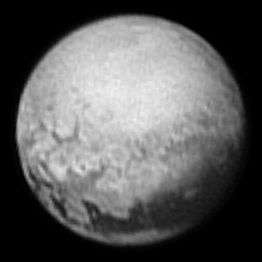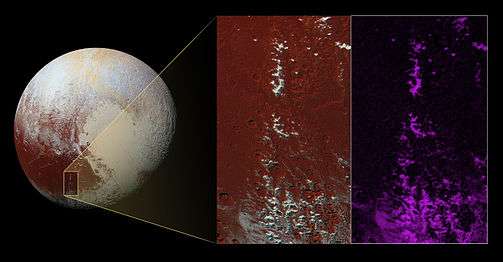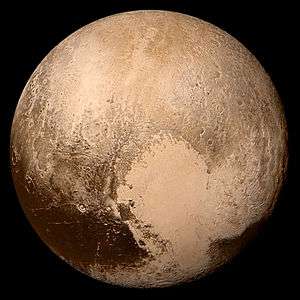Cthulhu Regio
 | |
| Location | Pluto |
|---|---|
| Coordinates | 0°N 90°E / 0°N 90°ECoordinates: 0°N 90°E / 0°N 90°E |
| Length | 3,000 km |
| Width | 1,000 km |
| Eponym | Cthulhu |
Cthulhu Regio /ˈkᵊθuːluː ˈrɛdʒi.oʊ/ is a prominent surface feature of the dwarf planet Pluto, that is reminiscent of a whale in shape. It is an elongated dark region along Pluto's equator, 2,990 km (1,860 mi) long and one of the darkest features on Pluto.[1] It is west of the Sputnik Planitia region of Tombaugh Regio, also known as Pluto's "heart", and to the east of Meng-P'o, the easternmost of Pluto's "Brass Knuckles".[2]
Description
The dark color of the region is speculated to be the result of a "tar" made of complex hydrocarbons called tholins covering the surface, which form from methane and nitrogen in the atmosphere interacting with ultraviolet light and cosmic rays.[3][4][5] Tholins have been observed on other planetary bodies, such as Iapetus, Umbriel, and in the atmosphere of Titan, although the irregular and disconnected nature of the dark spots on Pluto has not yet been explained.[3] The presence of craters within Cthulhu indicates that it is perhaps billions of years old, in contrast to the adjacent bright, craterless Sputnik Planitia, which may be as little as 100 million years old;[6] however, some areas of Cthulhu Regio are smoother and much more modestly cratered, and may be intermediate in age. [7] Higher-resolution images of the border between the two regions indicate that lighter material from Sputnik Planitia, composed of nitrogen, carbon monoxide, and methane ices, may be invading and overlaying the easternmost part of the dark Cthulhu Regio.[8] As of 30 July 2015, the eastern "head" region had been imaged in much higher resolution than the western "tail" region.[9]
 The "head" region of the Cthulhu feature, with Sputnik Planitia at right
The "head" region of the Cthulhu feature, with Sputnik Planitia at right The "tail" region of Cthulhu, at the bottom of this image. The "head" extends beyond the right side of the visible portion of Pluto. Meng-P'o is visible at the extreme bottom left.
The "tail" region of Cthulhu, at the bottom of this image. The "head" extends beyond the right side of the visible portion of Pluto. Meng-P'o is visible at the extreme bottom left. This image shows a region at the border between Cthulhu's "head" (left) and the light, flat Sputnik Planitia (right), with Hillary Montes at center.
This image shows a region at the border between Cthulhu's "head" (left) and the light, flat Sputnik Planitia (right), with Hillary Montes at center. The white snow caps on a mountain range within Cthulhu Regio (enhanced color, center) coincide with the spectral signature of methane ice (purple in false-color MVIC image, right).
The white snow caps on a mountain range within Cthulhu Regio (enhanced color, center) coincide with the spectral signature of methane ice (purple in false-color MVIC image, right).
Naming
The feature was first identified in the initial image, first published on 8 July 2015, of Pluto returned after the New Horizons probe recovered from an anomaly that temporarily sent it into safe mode. NASA initially referred to it as the Whale in reference to its overall shape.[10] By 14 July 2015, the provisional name "Cthulhu" was being used by the New Horizons team. It was named after the fictional deity from the works of H. P. Lovecraft and others.[2] The character Cthulhu initially appeared in Lovecraft's 1928 short story "The Call of Cthulhu", as a malevolent entity hibernating within an underwater city in the South Pacific. It is the subject of worship by a number of human cults asserting that while it is currently trapped, Cthulhu will eventually return.[11]
Surface features of Pluto are being given provisional, informal names that are selected from a list generated from an online poll conducted earlier in 2015, along the theme of "creatures related to underworld mythologies."[2] "Cthulhu" was the most popular name in this category of the poll.[12] The name received positive reaction from the press and social media,[2][13] with a Chicago Tribune editorial supporting the name and its democratic origin.[14] The name Cthulhu may be submitted to the IAU as an official name.[2][15]
Cthulhu Regio contains many craters and linear features that have also been given informal names. Oort Crater, K. Edgeworth Crater, and Elliot Crater are large craters along Cthulhu's northern edge; Brinton Crater, Harrington Crater, and H. Smith Crater are near Cthulhu's eastern edge, and Virgil Fossa and Beatrice Fossa are linear depressions in Cthulhu's interior.[9]
See also
References
- ↑ Feltman, Rachel (8 July 2015). "New map of Pluto reveals a 'whale' and a 'donut'". The Washington Post. Retrieved 14 July 2015.
- 1 2 3 4 5 McKinnon, Mika. "Places on Pluto are Being Named for Your Darkest Imaginings". Retrieved 23 July 2015.
- 1 2 Petersen, C. C. "Why the Dark Spots on Pluto?". TheSpacewriter's Ramblings. Retrieved 23 July 2015.
- ↑ Moskowitz, Clara. "Strange Spots on Pluto May be Tar and Frost". Space.com. Retrieved 23 July 2015.
- ↑ Betz, Eric. "Pluto's bright heart and Charon's dark spot revealed in HD". Astronomy Magazine. Retrieved 23 July 2015.
- ↑ "NASA's New Horizons Finds Second Mountain Range in Pluto's 'Heart'". NASA. Retrieved 23 July 2015.
- ↑ http://www.hou.usra.edu/meetings/lpsc2016/pdf/2310.pdf
- ↑ "New Horizons Discovers Flowing Ices on Pluto". NASA. Retrieved 25 July 2015.
- 1 2 "Informal Names for Features on Pluto". New Horizons. Johns Hopkins Applied Physics Laboratory. 29 July 2015. Retrieved 31 July 2015.
- ↑ "NASA's New Horizons: A 'Heart' from Pluto as Flyby Begins". NASA. 8 July 2015. Retrieved 15 July 2015.
- ↑ Lovecraft, H.P. "The Call of Cthulhu". Wikisource. Retrieved 6 June 2012.
- ↑ Flood, Alison. "Will HP Lovecraft's deity give his name to a feature on Pluto?". the Guardian. Retrieved 23 July 2015.
- ↑ "How 'Mordor' and 'Cthulhu' found their way onto Pluto and its moons". Mashable. Retrieved 23 July 2015.
- ↑ "Tolkien and Lovecraft got spots on Pluto. Keep it that way.". Chicago Tribune. Retrieved 23 July 2015.
- ↑ Feltman, Rachel (14 July 2015). "New data reveals that Pluto's heart is broken". The Washington Post. Retrieved 14 July 2015.
External links
 Media related to Cthulhu Regio at Wikimedia Commons
Media related to Cthulhu Regio at Wikimedia Commons

.jpg)